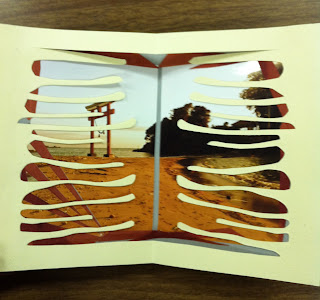This past weekend, a few Kagoshima JETs were lucky enough to participate in an artist workshop put on by a visiting artist and JET alumni, Thien-Kieu Lam. The daylong workshop was hosted by Yanedan, the local artist commune just outside Kanoya.
Kieu is working on a project called Bound in Japan. Using bookarts as a medium, the artist wishes to explore the many variations of the expat experience in Japan, as well as internationalization through the workshops themselves. If you are still curious, check out her website here:
http://boundinjapan.com/2011/06/30/star-books-at-yanedan/
We made star books, which are going to be displayed in her upcoming exhibition at a gallery in Kagoshima City. From there she will go north and do more workshops in Kansai and other areas. It felt great to be making art again, and it was really nice to make a piece that was in some way representative of my experience in Japan. Although Mare Blocker (amazing bookartist and Whitman professor) would probably look disapprovingly at my glue job and messy cutting, I made the whole thing in about four hours! So under the conditions, I’d say it went pretty well. In fact all the participants made really great pieces!
Content was supposed to loosely revolve around making a sort of guidebook for our area, i.e. some of our favorite places around Kagoshima, and our ideas of home/what home means to us.
Thanks again to Kieu for letting us participate in such a great project! Below are pictures of the cover and each of the pages of my book:
Cover page: photos sewn together were found ephemera, which I nicked from an old abandoned restaurant on Cape Sata. I used these found photos through out my book, and I’m guessing they’re anywhere from 15 to 25 years old, taken mostly of the Cape Sata area in southern Kagoshima.
Page One: Center picture is Nogyo Koko, my base agricultural high school, which has truly been a home away from home for me this year. The blue pieces also came from the found pictures (they were pictures of plates of food).
Page Two: Shrine Beach- one of the beaches closest to Kanoya on Kinko Bay, which we often go to. It has a little shrine up on the hill on the outcropping rock.
Page Three: The spliced picture is of one of my favorite restaurants in Kanoya, Takete, which serves the absolute best tonkatsu in all of Kagoshima (all of Japan?!) Tonkatsu, which is fried pork, is a specialty of Kagoshima. This restaurant has the most wonderful atmosphere, and everything from the meat to the miso to the fluffy rice is top quality. I especially love the head chef there, who we call the mustache man due to his outstanding mustache, which sticks out about two inches on either side of his face.

Page four: The back picture is of my friends Anna and Fiona, outside of Joyfull. I wanted to incorporate this picture, because I kind of think that Joyfull, which is a pretty gross family restaurant chain in Japan (kind of equivalent to Denny’s or Sherry’s in America) is really an important part of the inaka (rural) Japan experience. They are EVERYWHERE, and open twenty-four hours, so we often find ourselves at Joyfull simply when we have nothing better to do, or when we need some late night greasy food. Joyfull saved Tyler and I many times when traveling on the rural islands, we found ourselves in desperate need of refuge from the rain. I’ve had so many times of just ridiculous silliness in Joyfull. Anyhow, it’s truly inaka. The top photo of the power lines is again a found picture.
Page five: For the last page I decided to use a poem by one of my favorite Japanese poets, Saigyo.
"If I can find
no place fit to live
let me live "no place"-
in this hut of sticks
flimsy as the world itself"
While maybe the whole Buddhist theme of transience doesn’t really have to do with Kagoshima as a home for me in particular, I do think the poem reflects this place in some way, which is to me so beautiful in its rustic state. Sometimes it feels as though the derelict buildings around here will be taken back by nature at any moment- half falling apart and forgotten. The Japanese people really live by the mercy of nature: it permeates all aspects of life here.
messy workspace...
participants and their final books!

















